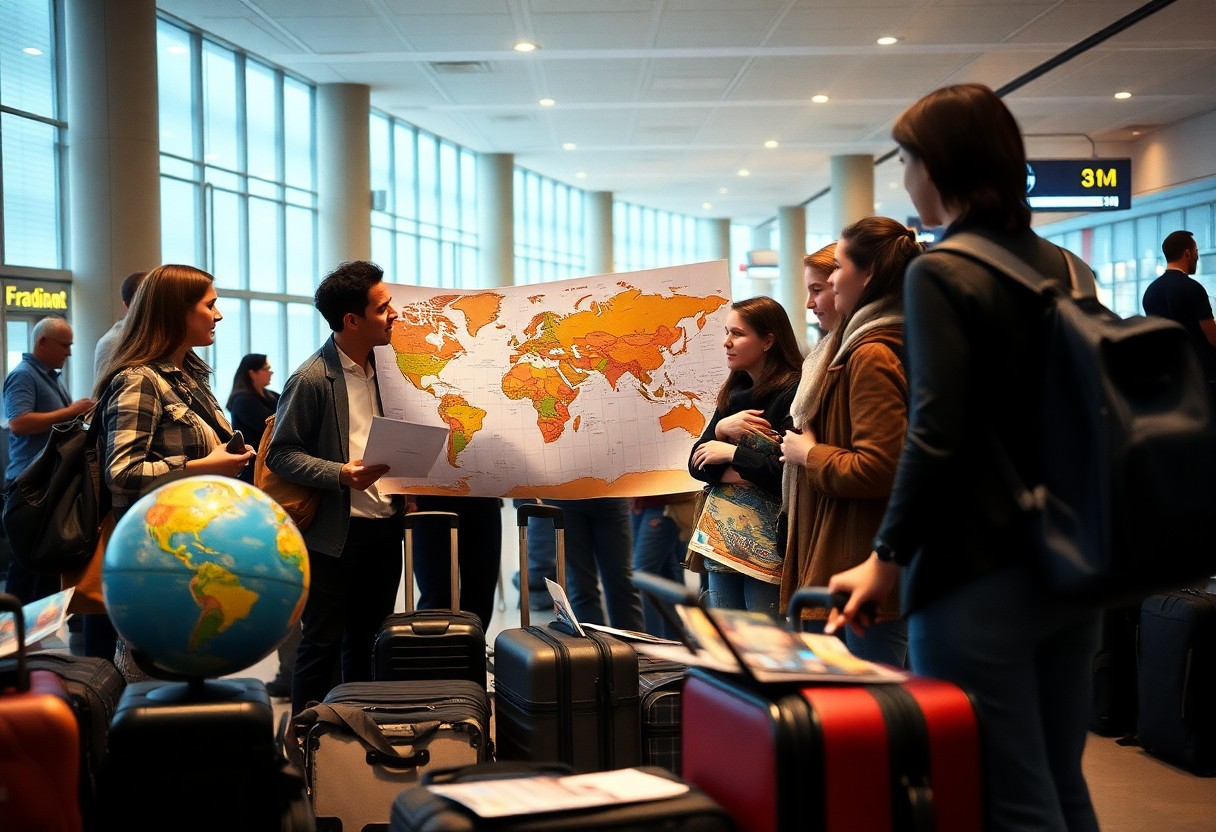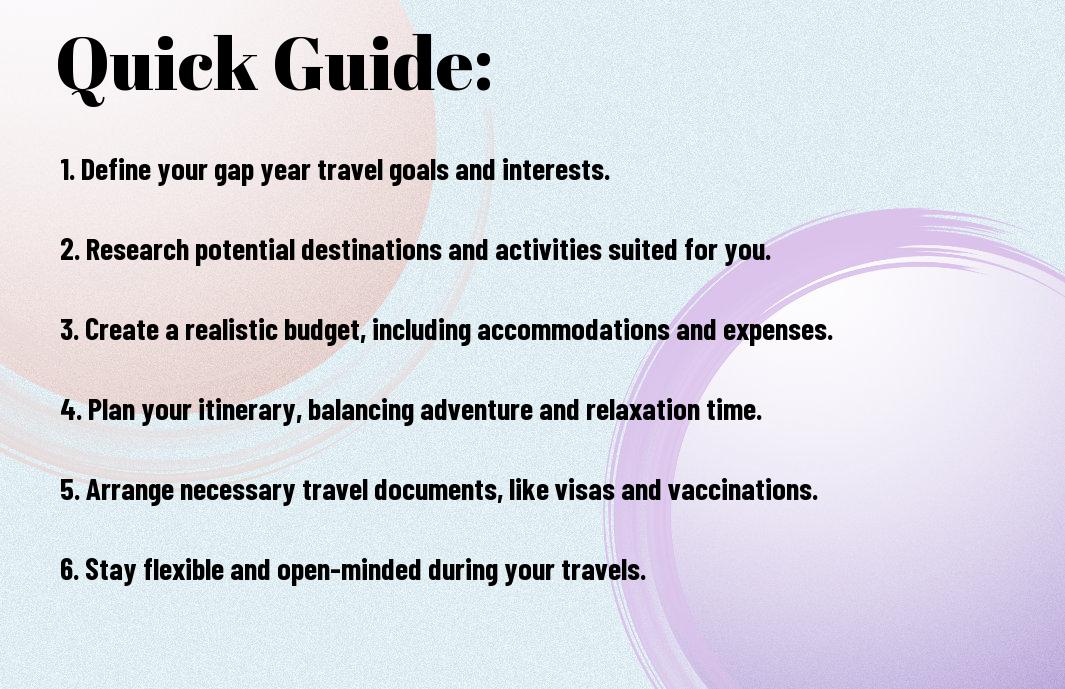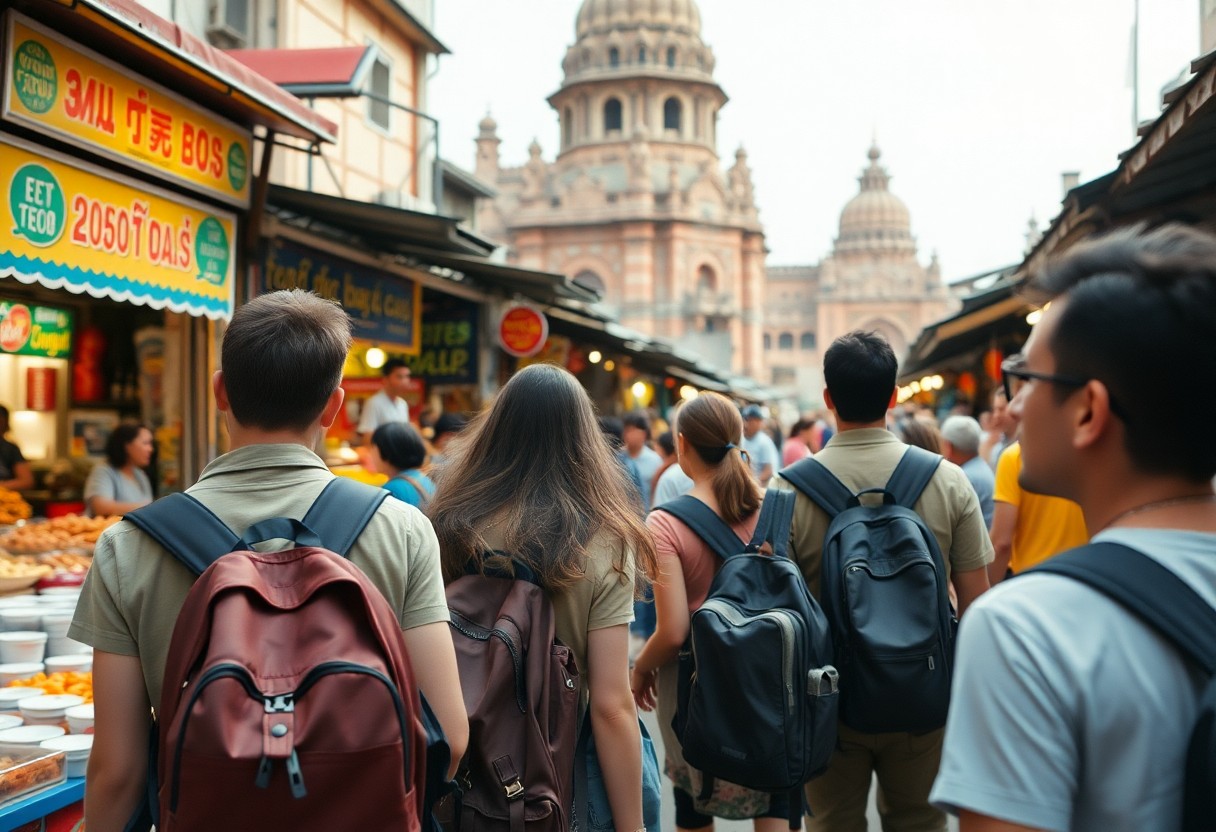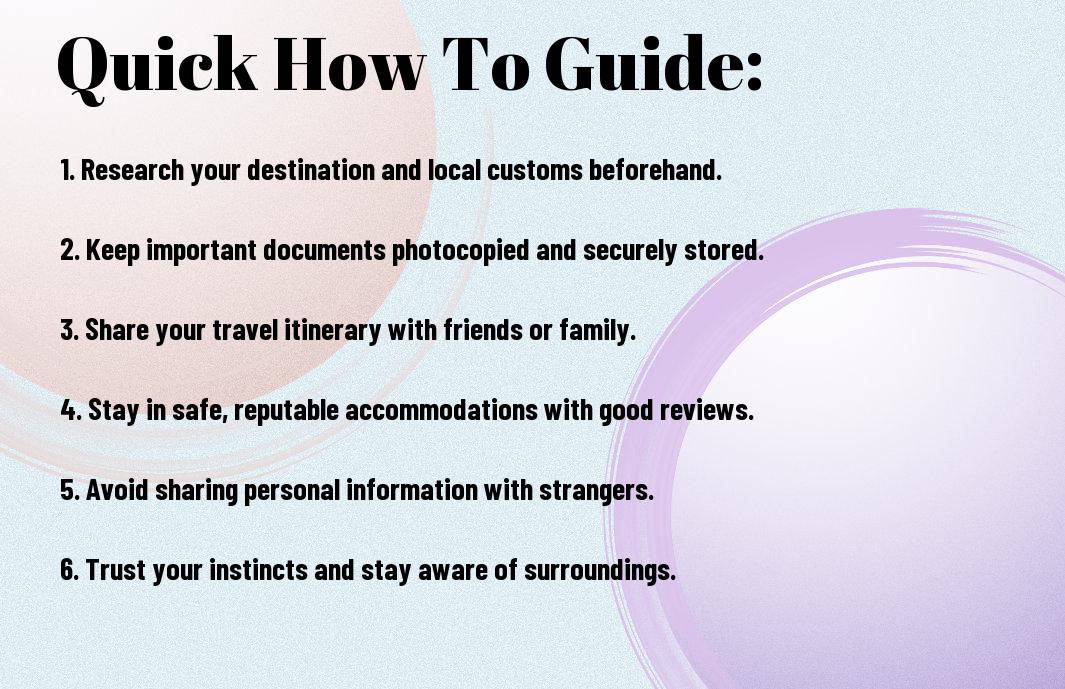This guide will equip you with vital tips and strategies for making the most of your international travel during peak season. With more travelers on the move, it’s vital to navigate the challenges that come with busy airports and popular destinations. You’ll discover practical advice on planning, booking, and packing, ensuring that your travel experience is smooth and enjoyable, even amidst the crowds. Dive in and learn how to optimize your adventures while avoiding common pitfalls that can arise during this bustling time of year.
Key Takeaways:
- Plan Ahead: Book flights and accommodations as early as possible to secure the best options and prices.
- Be Flexible: Consider traveling during off-peak times or adjusting your travel dates to avoid crowds and high costs.
- Research Destinations: Understand the peak times and events at your chosen destination to better navigate busy periods and plan activities accordingly.
- Pack Smart: Keep your luggage light to ease airport navigation and transportation, allowing for smoother transitions between locations.
- Stay Informed: Monitor travel advisories, local weather conditions, and any restrictions that may impact your trip to stay prepared.
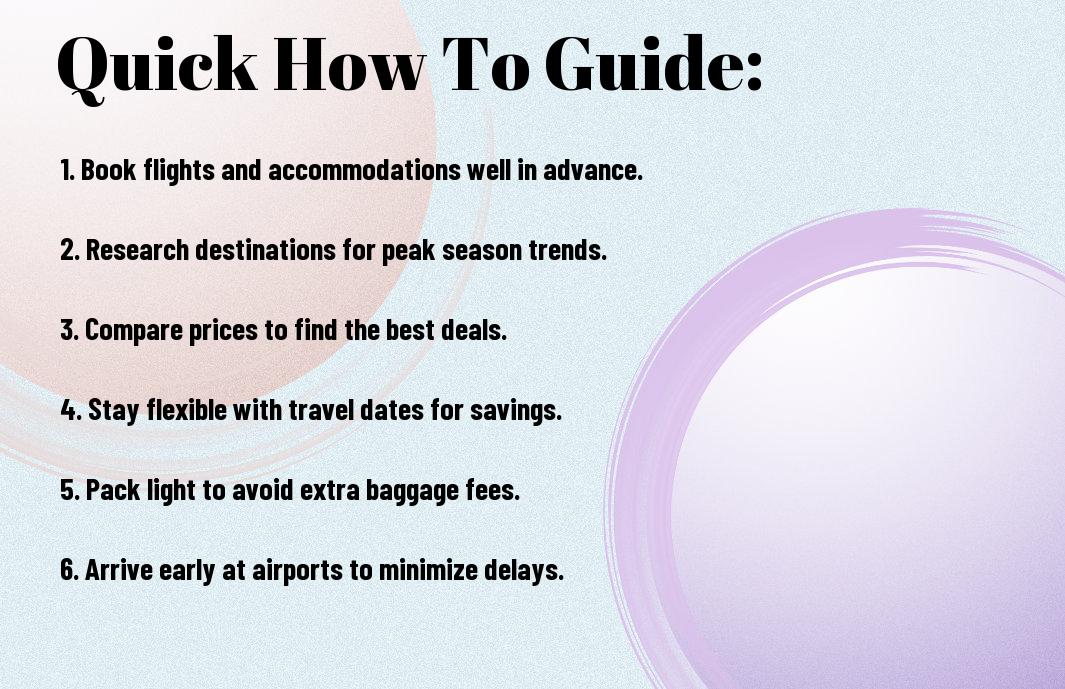
Understanding Peak Season
Your travel experience significantly hinges on the timing of your trip. Peak season marks the period when travel demand surges, leading to crowded destinations and elevated prices. Knowing when these busy times occur can help you navigate challenges and make better choices for your travels, ensuring you get the most out of your adventure without the overwhelming tourist rush.
Identifying Peak Travel Times
There’s a pattern to when peak travel times occur, often linked to holidays, school vacations, and seasonal attractions. For instance, summer months tend to be busy in many countries, while winter holidays can also create surges in certain destinations. Keeping an eye on local calendars and popular travel trends can help you pinpoint these busy periods.
Factors Influencing Peak Season Travel
Now, several factors impact when peak travel seasons take place, affecting your travel plans directly. Some of these include:
- National holidays and festivals
- School vacation schedules
- Weather conditions that draw tourists
- Major events such as international conferences or sports competitions
Recognizing these elements can guide you in planning your trip and avoiding the busiest times.
The timing of your travel can also be influenced by global trends and economic shifts. Specific events, such as world expos or significant local celebrations, can draw thousands and create spikes in visitors. Additionally, the popularity of certain destinations can evolve, pushing them into peak status at unexpected times. Consider these factors when planning your journey:
- Current travel deals and economic outlook
- Local attractions and their seasonal availability
- Cultural significance of certain travel dates
- Travel restrictions and guidelines that can change rapidly
Recognizing these factors allows you to make informed decisions about when to secure your bookings and enjoy a more tailored travel experience.
How to Plan Your Trip
Even during peak travel season, effective planning can make a huge difference. Start by researching travel guidelines to How To Escape the Crowds When Traveling (Even During Peak Times). Consider booking your flights and accommodation well in advance to secure better rates and availability. Keeping your options open can lead to a more enjoyable experience and help you navigate busy tourist destinations successfully.
Choosing the Right Destination
For your trip, selecting the right destination can significantly enhance your travel experience. Look for locations that are not only popular but also have various attractions that draw the crowds. Exploring off-the-beaten-path sites can provide unique experiences while steering clear of tourist traps, allowing you to enjoy your vacation without the hustle and bustle.
Creating a Flexible Itinerary
Destination planning should allow for some spontaneity in your itinerary. A rigid schedule can lead to stress, especially in crowded places. Instead, outline your must-see attractions but leave time for unexpected finds and local events. This flexibility empowers you to adjust your plans in real-time based on weather, crowd conditions, or personal preferences.
This approach not only reduces pressure but also enriches your travel experience. By including buffer time between activities, you can relax and explore at your own pace. You might stumble upon hidden gems and local culture that you wouldn’t have experienced with a strict agenda. Embracing a flexible itinerary means your trip can evolve, allowing you to make the most of your time away.
Booking Strategies
Once again, successful international travel during peak season requires careful planning and smart booking strategies. Aim to book your flights and accommodations several months in advance to secure the best prices and availability. Utilizing fare comparison websites can also help you find better deals and track fluctuations, allowing you to book at the right moment. Always be flexible with your travel dates and consider alternative airports that may offer lower fares.
Finding the Best Deals
There’s no shortage of online tools and resources to help you locate the best travel deals. Sign up for fare alerts, use travel reward programs, and consider booking packages that include both flights and accommodations. Also, keep an eye on last-minute deals, as airlines and hotels often lower prices to fill seats or rooms as departure dates approach. Collaborate with other travelers to share tips and resources that can enhance your booking experience.
Understanding Cancellation Policies
Little is often shared about the importance of understanding cancellation policies. Before making any reservations, take the time to read the fine print related to cancellations and changes. This knowledge can save you from unexpected fees and headaches later on. Knowing whether you can receive a full refund, a partial refund, or if you’re subject to non-refundable fees will help you make informed decisions.
To ensure peace of mind while traveling during peak season, familiarize yourself with the specific cancellation policies of airlines and accommodations. Policies can vary significantly, so it’s advisable to choose options that provide the greatest flexibility. Look for services that offer free cancellation within a certain timeframe or those that allow you to make changes without hefty penalties. By doing your due diligence, you can greatly reduce the risk associated with unforeseen changes in your travel plans.
Travel Tips for the Peak Season
Now that you’re ready for your international adventure during peak season, consider these travel tips to enhance your experience:
- Book flights and accommodations well in advance.
- Be flexible with your travel dates to find better prices.
- Arrive at the airport earlier than usual.
- Use mobile apps for real-time updates on your travel plans.
- Stay informed about local customs and peak times at attractions.
The right preparation can make your trip unforgettable.
Packing Essentials
Packing efficiently is vital during peak season, ensuring you have everything you need without hinderance. Opt for lightweight clothing that can be layered, and include portable chargers for your devices. Always pack a refillable water bottle and travel-sized toiletries to save space. Remember to bring any necessary documents and keep a small first-aid kit handy for minor inconveniences.
Navigating Crowds Efficiently
While crowds can be overwhelming during peak season, there are strategies to navigate them effectively. Choose early morning or late afternoon to visit popular attractions, as these times are often less crowded. Use public transportation to avoid long waits for taxis and rideshares. Additionally, consider pre-booking tickets for attractions online, allowing you to skip long lines on-site.
Tips for navigating crowds also include staying informed about local events or festivals, which may impact crowd levels. Familiarize yourself with alternative routes and hidden gems away from the tourist hotspots. Utilize smartphone apps for live maps and crowd reports to change your plans swiftly. Leverage this knowledge to maximize your enjoyment while minimizing stress, ensuring your trip remains memorable.

Accommodation Choices
Unlike visiting during off-peak seasons, booking accommodations during peak travel times can be challenging. The demand for rooms increases, often leading to higher prices and limited availability. You need to explore a range of options that cater to different budgets and preferences, ensuring you find a suitable place to stay while enjoying your travels.
Types of Accommodations
Even though hotels are often the go-to for travelers, there are several types of accommodations available to consider:
| Hotels | Comfortable and often amenity-rich |
| Hostels | Budget-friendly, great for meeting fellow travelers |
| Vacation Rentals | Home-like experience with kitchen facilities |
| Bed and Breakfasts | Cozy, personalized stays with breakfast provided |
| Camping | An adventurous and affordable option |
Recognizing the variety available can help you make informed decisions tailored to your travel style and needs.
Tips for Booking during Peak Season
Choices made during peak season can significantly affect your travel experience. Here are several strategies to improve your booking process:
- Book your accommodations as far in advance as possible
- Consider flexible dates to find better rates
- Utilize comparison websites to explore options
- Sign up for alerts on price drops and special deals
Assume that planning ahead will offer you the best opportunities
This approach can ensure you secure the set-up you desire during busy travel periods. Follow these guidelines for an efficient booking experience:
- Use direct hotel websites for potential member discounts
- Explore lesser-known areas for hidden gems
- Be prepared to alter your choices based on availability
- Stick to your budget but remain open to splurging if justified
Assume that your flexibility will lead to the most fulfilling stay with plenty of memorable experiences.
Transportation Considerations
Keep in mind that transportation logistics can significantly impact your peak season travel experience. It’s crucial to plan ahead and account for potential delays and busy travel times, ensuring you have reliable options for getting to and from your destination.
Airport and Public Transport Tips
If you’re navigating airports or public transport, consider these tips:
- Book your tickets in advance to secure better rates.
- Arrive early to account for crowds and long security lines.
- Use mobile apps for real-time updates on transport schedules.
- Opt for off-peak travel times when possible.
Knowing these strategies can enhance your travel experience, ensuring smoother transitions between locations.
Alternatives to Traditional Travel
Little did you know, there are many alternatives to traditional travel for navigating your peak season journey efficiently. Consider options like rideshare services, scooters, and bike rentals, which can help you avoid congested public transport and long taxi queues.
Public transportation can often be crowded during peak season, leading to delays and discomfort. By exploring alternatives such as local rideshare services, cycling, or even walking, you can enjoy a more personalized travel experience while avoiding the chaos. This flexibility not only adds spontaneity to your trip but can also save you time, allowing you to focus on enjoying your destination.
To wrap up
Ultimately, traveling internationally during peak season can be a seamless experience when you plan ahead and stay organized. Ensure you book flights and accommodations in advance, utilize travel apps for real-time updates, and consider alternative transportation options to avoid long lines. Packing efficiently and being flexible with your itinerary will enhance your journey. By following these tips, you can enjoy your travel adventures while navigating the busyness of peak season with ease and confidence.
FAQ
Q: What are the best strategies for booking flights during peak travel season?
A: When booking flights during peak travel season, timing and flexibility are necessary. Start by monitoring flight prices several months in advance using flight comparison websites. Try to book your tickets mid-week, as weekend prices can be higher. Additionally, consider flying during off-peak hours, such as early morning or late evening flights, which may be less crowded and more affordable. If possible, maintain some flexibility with your travel dates to take advantage of fare differences.
Q: How can I efficiently plan my itinerary to accommodate larger crowds?
A: To navigate larger crowds during peak season, prioritize early arrivals at popular attractions, ideally before they open. Incorporate lesser-known sights or alternate destinations into your itinerary for a more enjoyable experience. Researching what events or festivals coincide with your travel dates can also help you avoid surprise crowd surges. Finally, consider making reservations for tours and dining well in advance to skip long waits.
Q: What tips can help me avoid common pitfalls while traveling during peak season?
A: To avoid common pitfalls during peak season travel, stay organized by keeping all travel documents, itineraries, and accommodation confirmations easily accessible. Utilize mobile apps for real-time updates on flight statuses and attraction hours. Additionally, be prepared for potential delays and crowds by allowing extra travel time. Packing light can also ease movement through busy airports and tourist areas. Last but not least, maintaining a positive attitude can enhance your travel experience despite any inconveniences.



